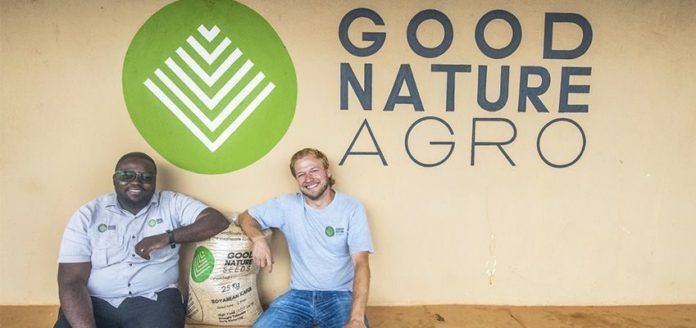Zambia has rich arable land, but only 15% of it is utilised whilst its predominantly rural population is highly dependent on agriculture and 60% of households participate.
According to the Food and Agriculture Organisation (FAO) 50% get their livelihood from farming activities.
This has seen the Good Nature Agro (GNA) intervening.
The start-up figured that one way to help smallholders transition from poverty to the middle class was through higher income-generating crops such as legumes.
Legumes promote better soil health too and are often used as nitrogen-fixing cover crops in the western world.
By supplying legume seeds and working with farmers on how to grow them, who to sell them to, and how to get good yields, the start-up works with Zambia’s smallholder farmers to help them produce high quality legumes for export.
Founded by Carl Jensen and Sunday Silungwe, GNA’s aim is to create a group of smallholder farmers who are financed, trained and have access to high-quality information and inputs.
“Our business is built on trying to maximise lifetime value, the nature and also long term impact of the farmer,” Carl Jensen, CEO and co-founder of GNA, said.
GNA’s core product is high-quality and specialised seed for a range of legume crops including cowpea, groundnut, soybean, common bean and pigeon pea.
It also provides microbial fertilisers and inoculants that work with the soil to improve nitrogen fixation.
The social enterprise first identifies high-value premium markets for legumes and establishes agreements with food processors. It then contracts smallholders to fulfil these agreements.
GNA makes sure that they have a ready market that’s transparent and that they know about before the season begins. This is guaranteed by purchasing the entire crop harvest at the end of the season from the farmers.
High poverty levels in Zambia are bound to affect its smallholders. Around 78% of the country’s population lives below the poverty line. Ultimately, this means that farmers have to find ways to survive in between farming seasons.
GNA is going beyond seed provision to include availing credit to 25 000 farmers helping them to cover 80% of their input costs on average. Its financing model is flexible and some farmers can qualify for 100% financing depending on their credit scores. GNA lends off its own books and has seen just 6% default rates across its portfolio.
“We have different credit scores so that farmers start with relatively small packages, but then add on additional hectares and inputs over time. And we purchased the seed and commodity that’s produced back from those growers, usually at a premium price of about 25 to 30%,” Jensen notes.
Farmers from GNA’s second credit tier or higher also get to receive advances prior to harvest, two months early. Often known as the lean season in smallholder agriculture, farmers are usually running out of money and therefore make desperate decisions. The advance comes in handy and GNA recovers it at harvest.
By the end of the year, at least 35 000 farmers will be included/
In working with its out-growers, GNA has very little criteria to be able to onboard the smallholders. This makes it very easy for farmers to join GNA’s out-grower programme. From that point, a farmer’s future ratings will determine how they advance.
“Our introductory package is relatively small and relatively affordable, where we’re talking about a half hectare of soybean sample that a farmer can access for about US$30. No other inputs are required, just seed and inoculant to help get that initial fixation,” says Jensen. And the smallholders only have to pay half of the amount upfront, so with a US$15 equivalent in Zambian kwacha, a farmer can join GNA’s programme.
From the entry point, GNA gauges the farmers based on the quality and quantity of the product they bring to the market, their attendance at training, farming practices and whether there’s any side selling. These are then used to construct a farmer’s subjective grower rating score.
“If they perform well with those metrics, they can do a much larger package the following year.”









